Investigation of the Microwave Absorption of Asphalt Mixtures Containing Magnetite Powder
Abstract
:1. Introduction
2. Materials and Methods
2.1. Materials
2.2. Sample Preparation
2.3. Microwave Heating Test
2.4. Bending Test
2.5. Freeze–Thaw Splitting Test
2.6. Reflection Loss Test
2.7. Microscopy and X-ray Diffraction (XRD) Test
3. Results and Discussion
3.1. Effect of Magnetite Powder Dosage on the Microwave Heating Performance
3.2. Effect of Magnetite Powder Dosage on Road Performance
3.2.1. Low-Temperature Properties
3.2.2. Water Sensitivity
3.3. Effect of MPAM Thickness on the Microwave-Absorbing Performance
4. Conclusions
- Low microwave absorption efficiency and high cost limit application of the deicing methodology using microwaves. Magnetite powders can be used as inexpensive microwave absorbers to improve the ability of microwave absorption and increase the heating rate of asphalt mixtures. The heating rates of asphalt mixtures increase with the increase of the amount of magnetite powders.
- The addition of magnetite powder improves the low-temperature properties of the asphalt mixture but reduces the water stability of the asphalt mixture.
- Considering that the microwave-absorbing asphalt mixture used for melting snow and ice should also have good water stability, the recommended dosage of magnetite powders is 60%.
- The microwave-absorbing properties of MPAM are related to its thickness in the pavement structure and frequency of microwaves. In order to greatly enhance the absorbing efficiency, future work should be focused on the matching thickness and matching frequency.
Author Contributions
Funding
Conflicts of Interest
References
- Du, Y.F.; Li, F.J.; Wang, S.Y.; Zhu, X. Inhibition and removal of thin ice on the surface of asphalt pavements by hydrophobic method. J. Insp. Eval. 2016, 44, 711–718. [Google Scholar] [CrossRef]
- Fay, L.; Shi, X.M. Environmental impacts of chemicals for snow and ice control: state of the knowledge. Water Air Soil Pollut. 2012, 223, 2751–2770. [Google Scholar] [CrossRef]
- Vo, H.V.; Park, D.W.; Dessouky, S. Simulation of snow melting pavement performance using measured thermal properties of graphite-modified asphalt mixture. Road Mater. Pavement Des. 2015, 16, 696–706. [Google Scholar] [CrossRef]
- Hassan, Y.; Halim, A.O.A.E.; Razaqpur, A.G.; Bekheet, W.; Farha, M.H. Effects of runway deicers on pavement materials and mixes: Comparison with road salt. J. Trans. Eng. 2002, 128, 385–391. [Google Scholar] [CrossRef]
- Benedetto, A.; Calvi, A. A pilot study on microwave heating for production and recycling of road pavement materials. Constr. Build. Mater. 2013, 44, 351–359. [Google Scholar] [CrossRef]
- Liu, Q.T.; Schlangen, E.; García, Á.; van de Ven, M. Induction heating of electrically conductive porous asphalt concrete. Constr. Build. Mater. 2010, 24, 1207–1213. [Google Scholar] [CrossRef]
- Wang, Z.G.; Dai, Q.L.; Porter, D.; You, Z.P. Investigation of microwave healing performance of electrically conductive carbon fiber modified asphalt mixture beams. Constr. Build. Mater. 2016, 126, 1012–1019. [Google Scholar] [CrossRef]
- Gao, J.; Zhang, Z.W.; Han, Z.Q.; Sha, A.M.; Wang, Z.J.; Jiang, W. A review of electromagnetic wave absorbing materials used in microwave deicing pavement. Mater. Rev. 2016, 30, 87–95. [Google Scholar] [CrossRef]
- Meng, F.B.; Wang, H.G.; Huang, F.; Guo, Y.F.; Wang, Z.Y.; Hui, D.; Zhou, Z.W. Graphene-based microwave absorbing composites: A review and prospective. Compos. Part B Eng. 2018, 137, 260–277. [Google Scholar] [CrossRef]
- Liu, J.L.; Xu, J.Y.; Lu, S.; Chen, H.W. Investigation on dielectric properties and microwave heating efficiencies of various concrete pavements during microwave deicing. Constr. Build. Mater. 2019, 225, 55–66. [Google Scholar] [CrossRef]
- Norambuena-Contreras, J.; Gonzalez-Torre, I. Influence of the microwave heating time on the self-healing properties of asphalt mixtures. Appl. Sci. 2017, 7, 1076. [Google Scholar] [CrossRef]
- Wang, Z.J.; Wang, H.F.; An, D.D.; Ai, T.; Zhao, P. Laboratory investigation on deicing characteristics of asphalt mixture using magnetite aggregate as microwave-absorbing materials. Constr. Build. Mater. 2016, 124, 589–597. [Google Scholar] [CrossRef]
- Sun, Y.H.; Wu, S.P.; Liu, Q.T.; Hu, J.F.; Yuan, Y.; Ye, Q.S. Snow and ice melting properties of self-healing asphalt mixture with induction heating and microwave heating. Appl. Therm. Eng. 2017, 129, 871–883. [Google Scholar] [CrossRef]
- Gao, J.; Sha, A.M.; Wang, Z.J.; Tong, Z.; Liu, Z.Z. Utilization of steel slag as aggregate in asphalt mixture for microwave deicing. J. Clean. Prod. 2017, 152, 429–442. [Google Scholar] [CrossRef]
- Notani, M.A.; Arabzadeh, A.; Ceylan, H.; Kim, S.; Gopalakrishnan, K. Effect of carbon-fiber properties on volumetrics and ohmic heating of electrically conductive asphalt concrete. J. Mater. Civ. Eng. 2019, 31, 04019200. [Google Scholar] [CrossRef]
- Sun, Y.H.; Wu, S.P.; Liu, Q.T.; Zeng, W.B.; Chen, Z.W.; Ye, Q.S.; Pan, P. Self-healing performance of asphalt mixtures through heating fibers or aggregate. Constr. Build. Mater. 2017, 150, 673–680. [Google Scholar] [CrossRef]
- Zhang, J.F.; Yan, Y.; Hu, Z.H.; Fan, X.Z.; Zheng, Y. Utilization of low-grade pyrite cinder for synthesis of microwave heating ceramics and their microwave deicing performance in dense-graded asphalt mixture. J. Clean. Prod. 2017, 170, 486–495. [Google Scholar] [CrossRef]
- Wang, Y.D.; Liu, Z.M.; Hao, P.W. Investigation on mechanical and microwave heating characteristics of asphalt mastic using activated carbon powder as electro-magnetic absorbing materials. Constr. Build. Mater. 2019, 202, 692–703. [Google Scholar] [CrossRef]
- Guan, B.W.; Ding, D.H.; Wang, L.F.; Wu, J.Y.; Xiong, R. The electromagnetic wave absorbing properties of cement-based composites using natural magnetite powders as absorber. Mater. Res. Express 2017, 4, 056103. [Google Scholar] [CrossRef]
- ASTM D5/D5M-19—Standard Test Method for Penetration of Bituminous Materials; ASTM International: West Conshohocken, PA, USA, 2019.
- ASTM D36/D36M-14e1—Standard Test Method for Softening Point of Bitumen (Ring-and-Ball Apparatus); ASTM International: West Conshohocken, PA, USA, 2014.
- ASTM D113-17—Standard Test Method for Ductility of Asphalt Materials; ASTM International: West Conshohocken, PA, USA, 2017.
- ASTM D3344-90(2015)—Standard Test Method for Total Wax Content of Corrugated Paperboard; ASTM International: West Conshohocken, PA, USA, 2015.
- ASTM D70-18a—Standard Test Method for Density of Semi-Solid Asphalt Binder (Pycnometer Method); ASTM International: West Conshohocken, PA, USA, 2018.
- ASTM D92-18—Standard Test Method for Flash and Fire Points by Cleveland Open Cup Tester; ASTM International: West Conshohocken, PA, USA, 2018.
- ASTM D2872-19—Standard Test Method for Effect of Heat and Air on a Moving Film of Asphalt (Rolling Thin-Film Oven Test); ASTM International: West Conshohocken, PA, USA, 2019.
- Standard Test Methods of Asphalt and Asphalt Mixtures for Highway Engineering, JTG E20; MOT: Beijing, China, 2011. (In Chinese)
- The Measurement Methods the Reflectivity of Radar Absorbing Materia, GJB 2038Al; CPLAGED: Beijing, China, 2011. (In Chinese)
- Hardianto, Y.P.; Taufiq, A.; Hidayat, A.; Sunaryono, S.; Listanti, A.; Wisodo, H. Nanostructure analysis for microwave absorption properties of Fe3O4 particles by symmetry top rotational molecular model. IOP Conf. Ser. Mater. Sci. Eng. 2018, 167, 012009. [Google Scholar] [CrossRef]
- Wang, Z.J.; Xu, C.; Wang, S.; Gao, J.; Ai, T. Utilization of magnetite tailings as aggregates in asphalt mixtures. Constr. Build. Mater. 2016, 114, 392–399. [Google Scholar] [CrossRef]
- Liu, Z.M.; Yang, X.; Wang, Y.D.; Luo, S. Engineering properties and microwave heating induced ice-melting performance of asphalt mixture with activated carbon powder filler. Constr. Build. Mater. 2019, 197, 50–62. [Google Scholar] [CrossRef]
- Ziari, H.; Divandari, H.; Hajiloo, M.; Amini, A. Investigating the effect of amorphous carbon powder on the moisture sensitivity, fatigue performance and rutting resistance of rubberized asphalt concrete mixtures. Constr. Build. Mater. 2019, 217, 62–72. [Google Scholar] [CrossRef]
- Technical Specification for Construction of Highway Asphalt Pavements in China, JTG F40; MOT: Beijing, China,, 2004. (In Chinese)
- Specification for Design of Highway Asphalt Pavement, JTG D50-2017; MOT: Beijing, China, 2017. (In Chinese)
- Ding, D.H.; Shi, Y.M.; Wu, Z.H. Electromagnetic interference shielding and dielectric properties of SiCf/SiC composites containing pyrolytic carbon interphase. Carbon 2013, 60, 552–555. [Google Scholar] [CrossRef]
- Ding, D.H.; Luo, F.; Zhou, W.C. Effects of thermal oxidation on electromagnetic interference shielding properties of SiCf/SiC composites. Ceram. Int. 2013, 39, 4281–4286. [Google Scholar] [CrossRef]
- Ding, D.; Wang, J.; Yu, X.; Xiao, G.; Feng, C.; Xu, W.; Bai, B.; Yang, N.; Gao, Y.; Hou, X.; et al. Dispersing of functionalized CNTs in Si–O–C ceramics and electromagnetic wave absorbing and mechanical properties of CNTs/Si–O–C nanocomposites. Ceram. Int. 2019. [Google Scholar] [CrossRef]
- Ding, D.; Wang, J.; Xiao, G.; Li, Z.; Bai, B.; Ren, J.; He, G. Enhanced electromagnetic wave absorbing properties of Si–O–C ceramics with in-situ formed 1D nanostructures. Int. J. Appl. Ceram. Technol. 2019. [Google Scholar] [CrossRef]
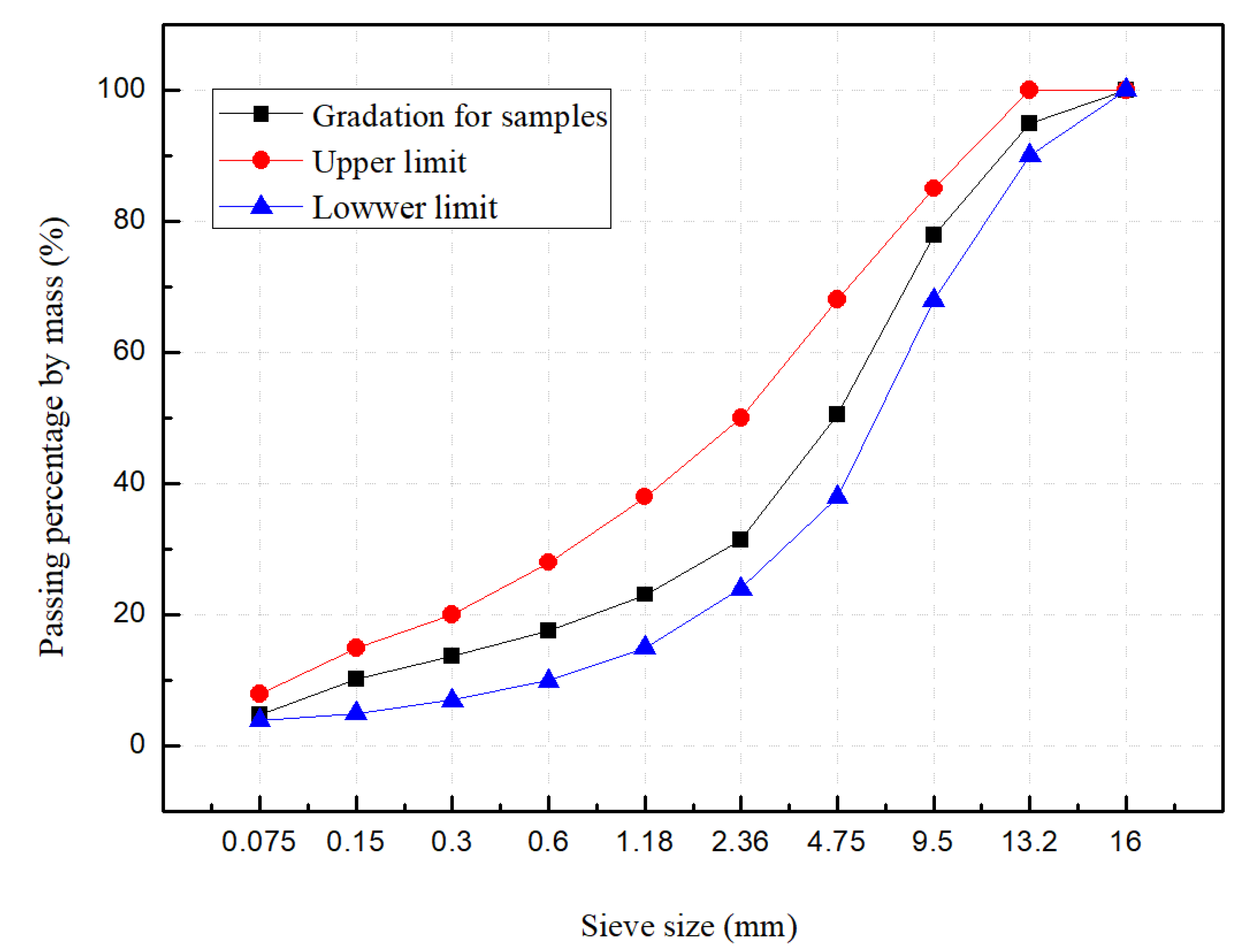
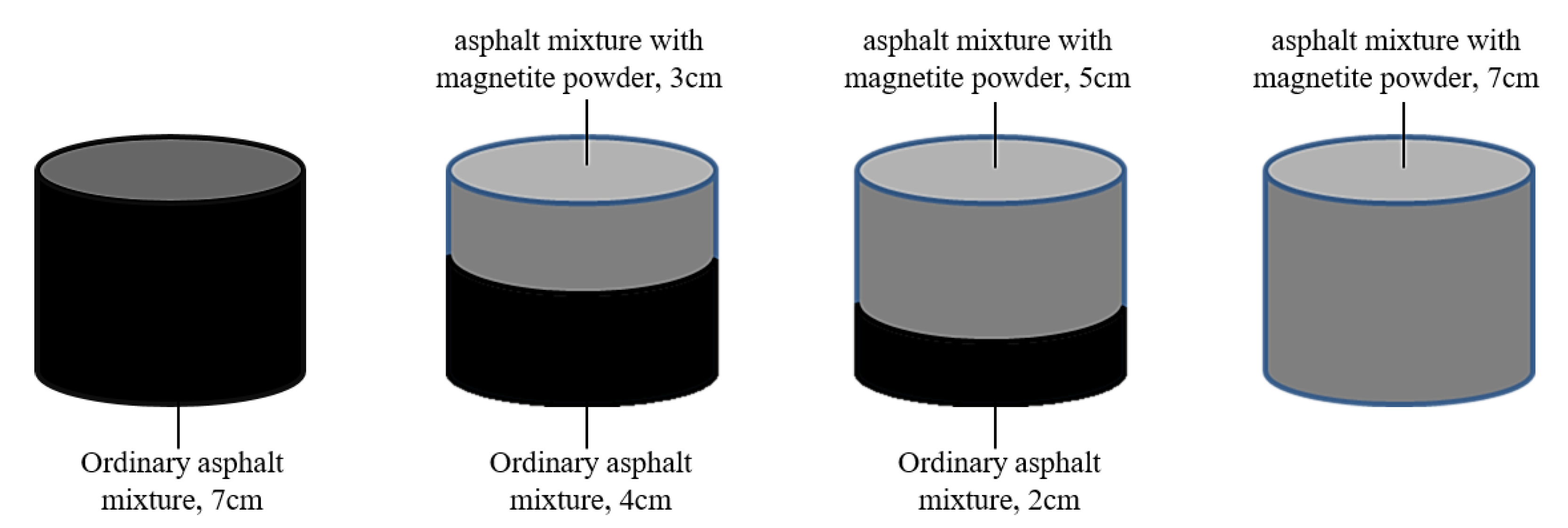

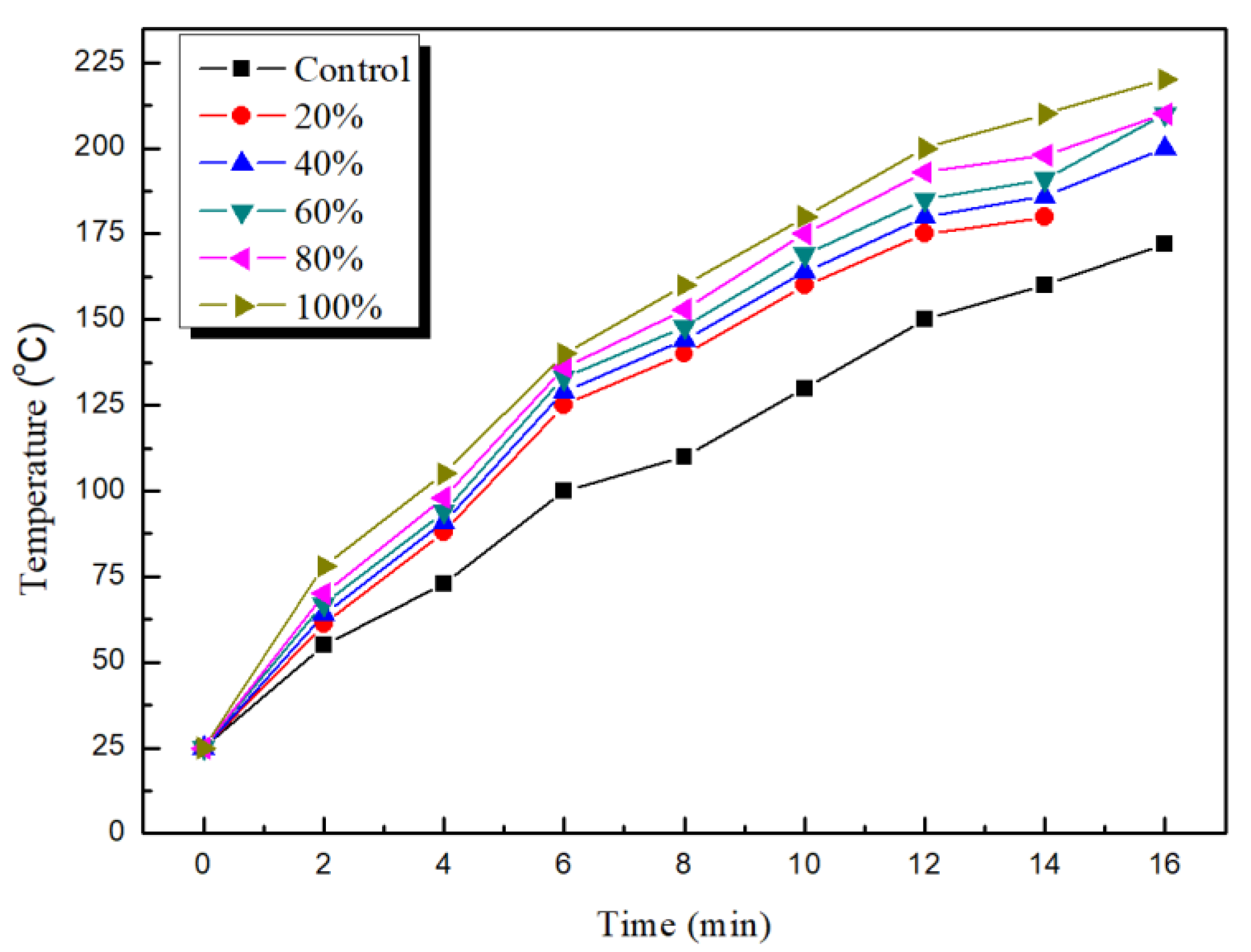
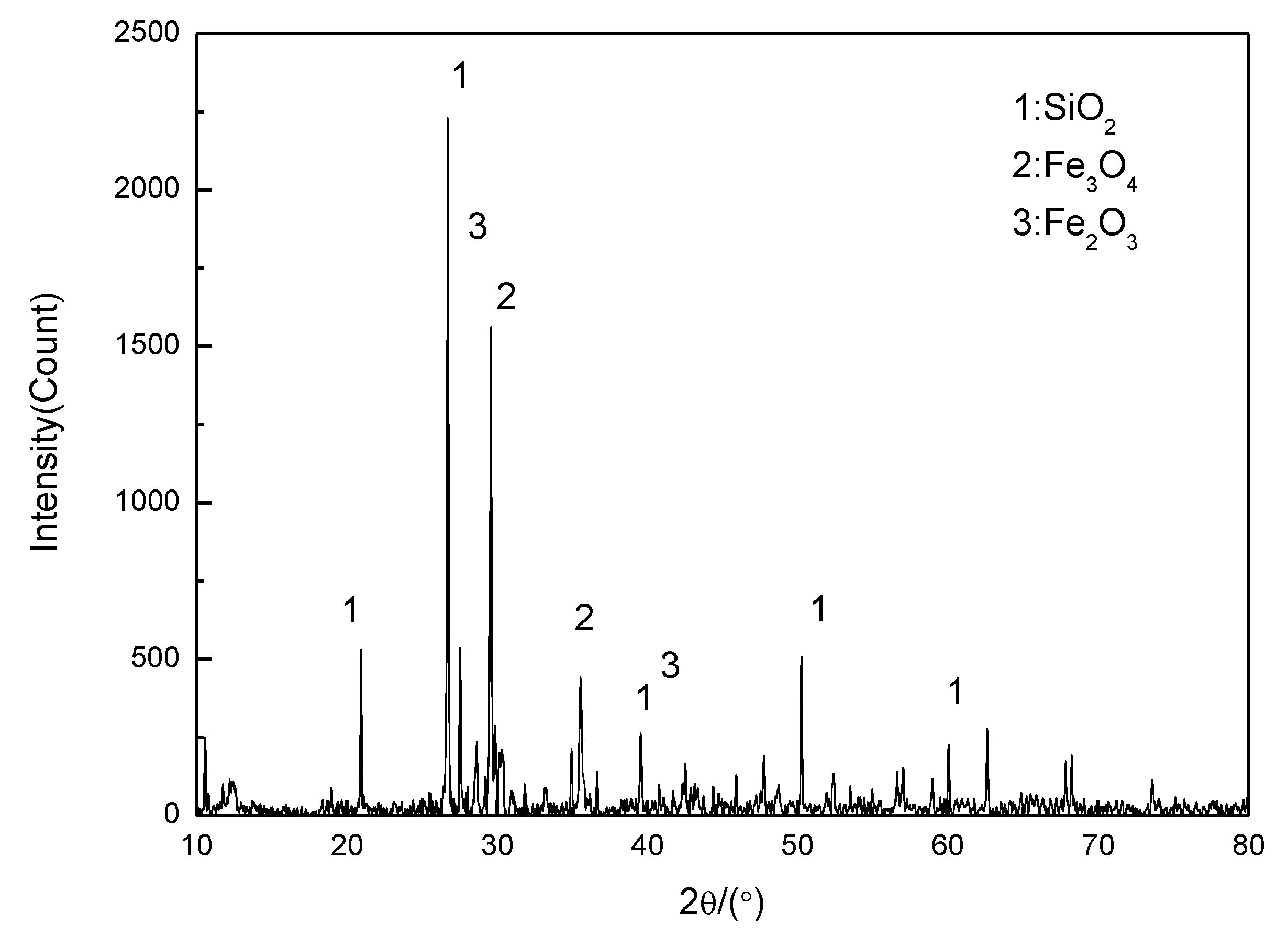
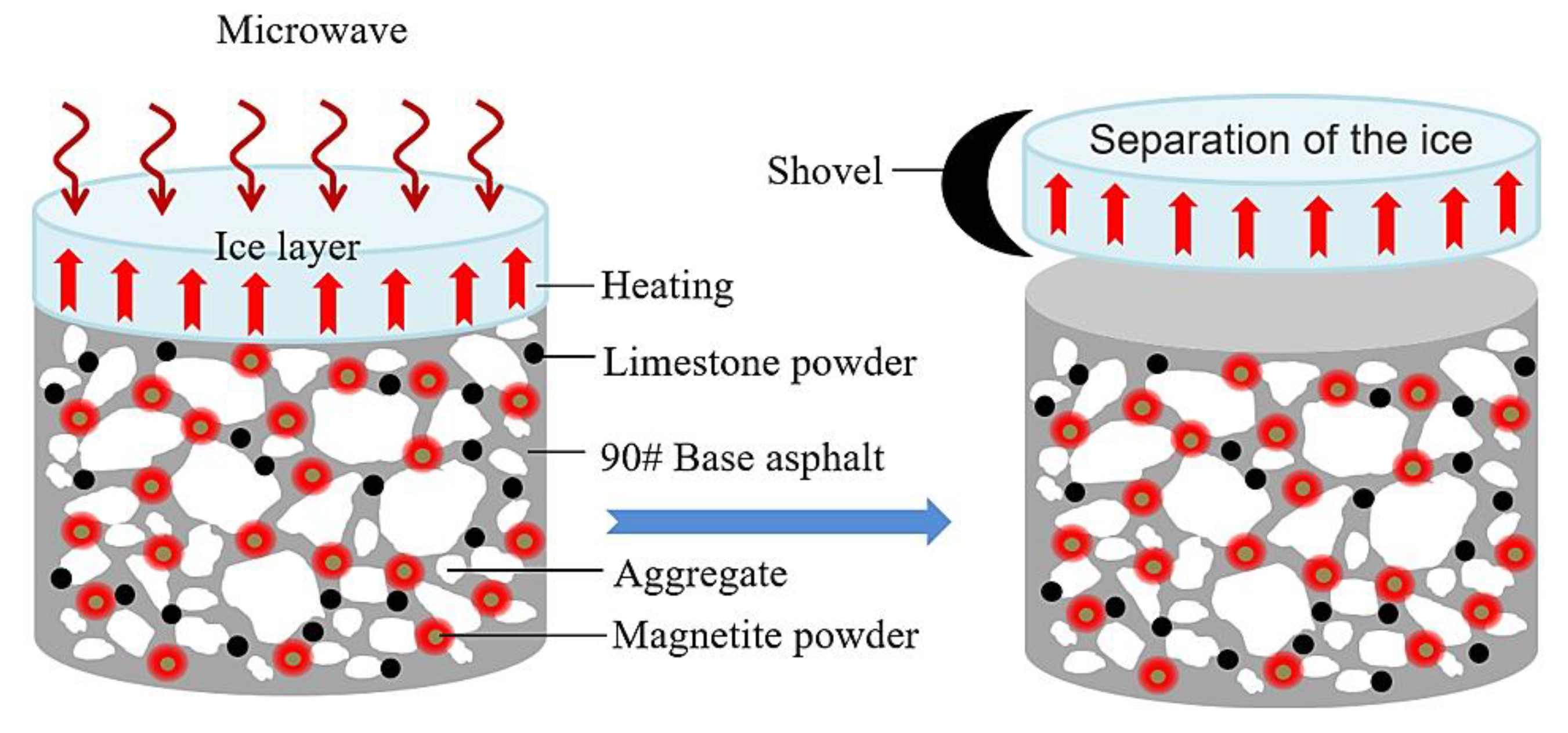
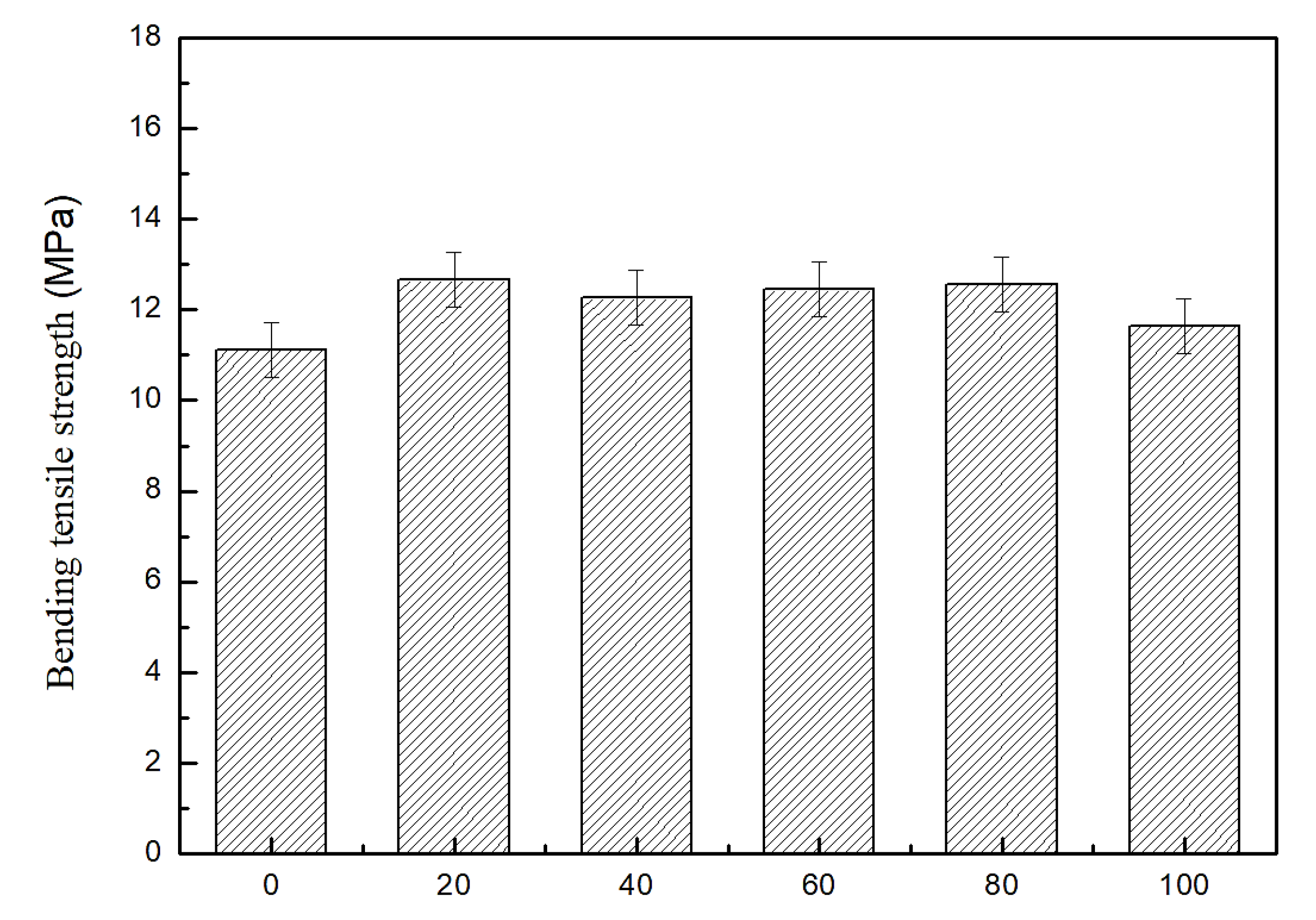

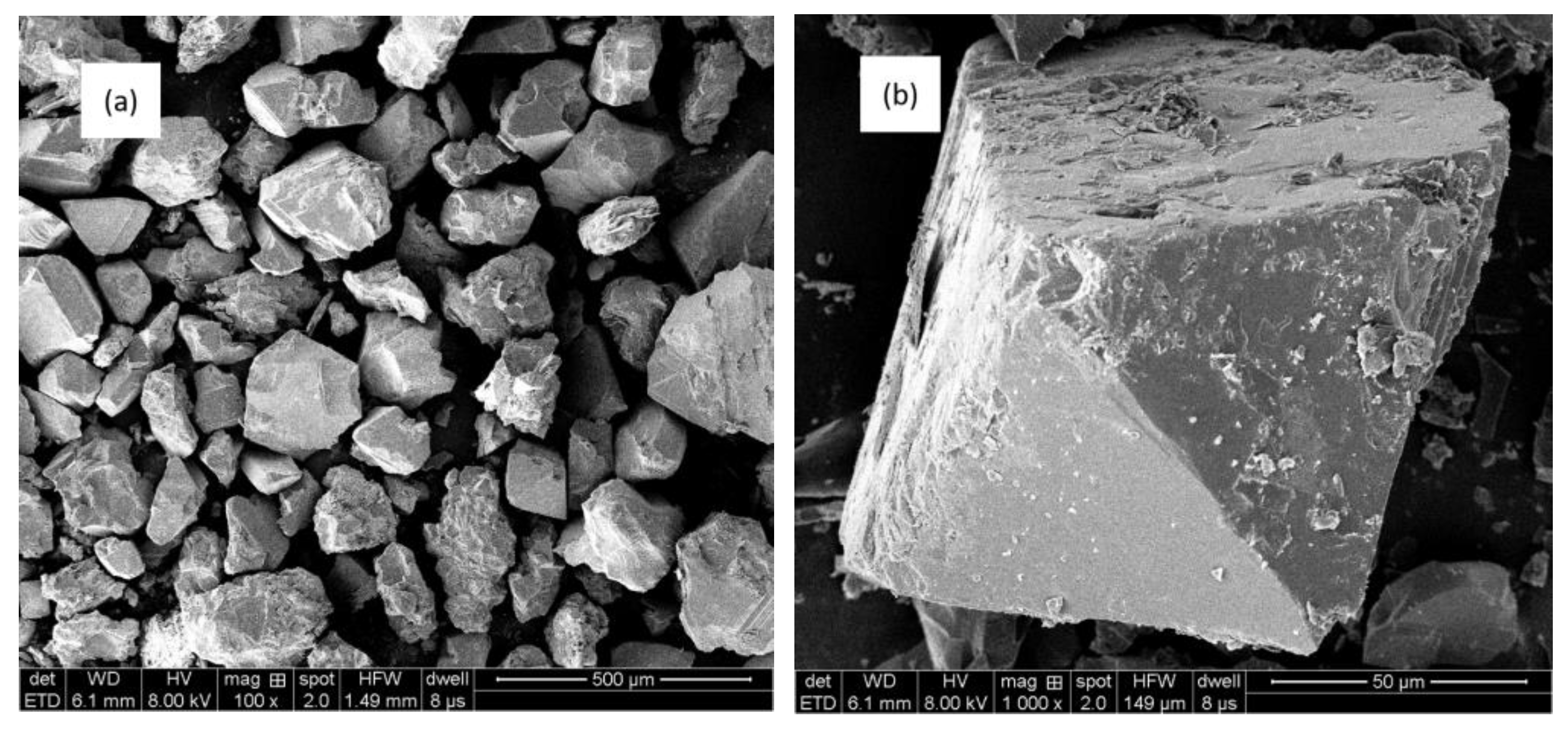
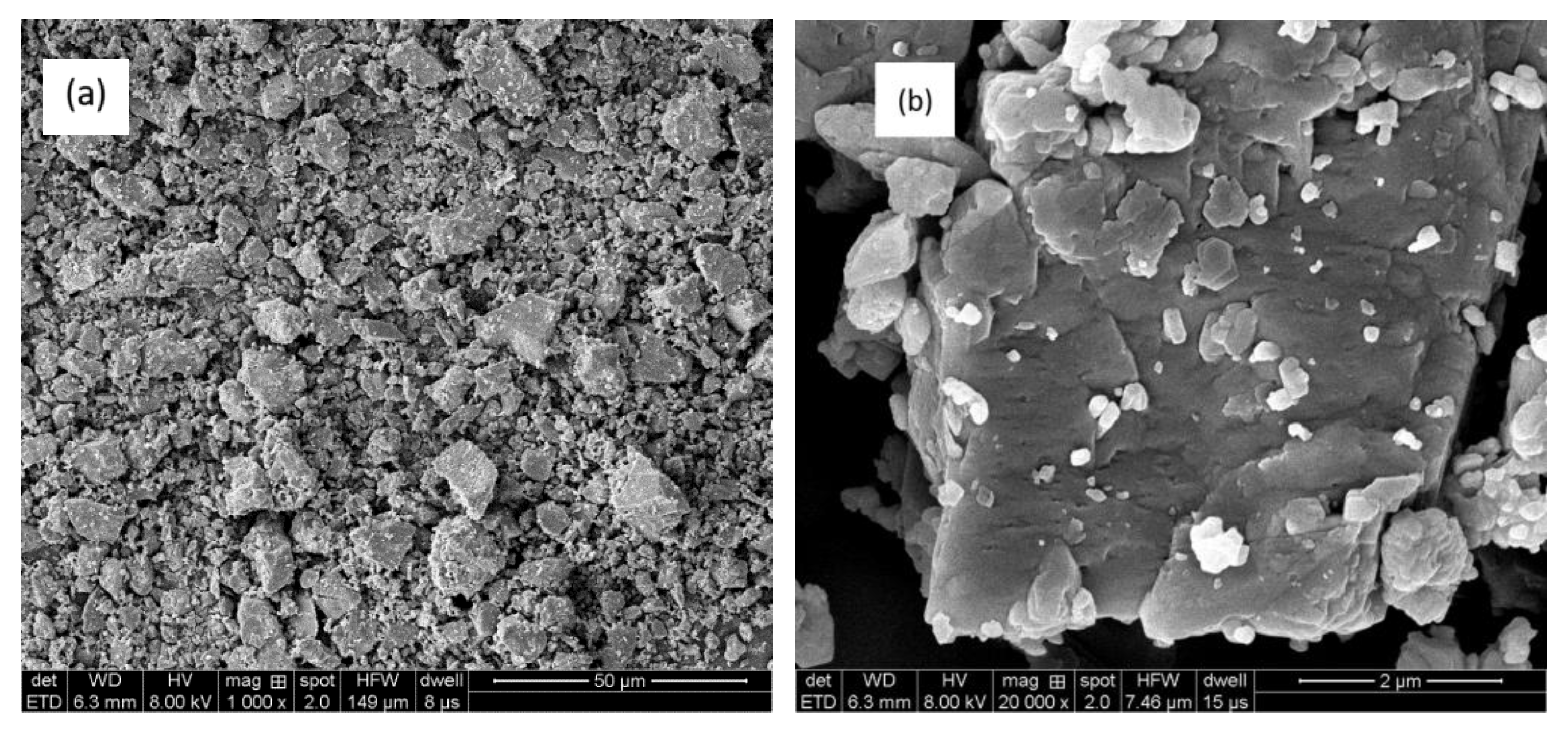
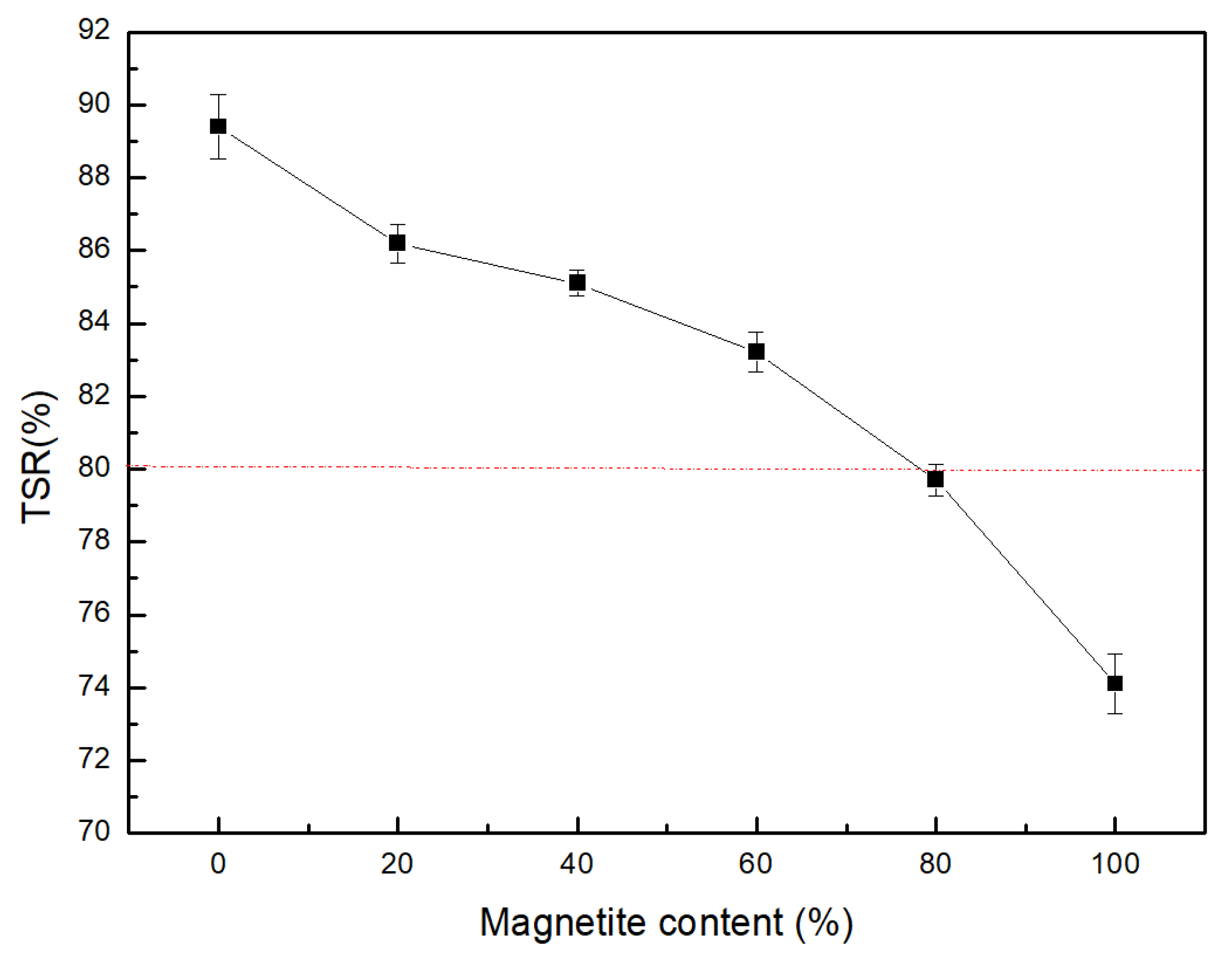
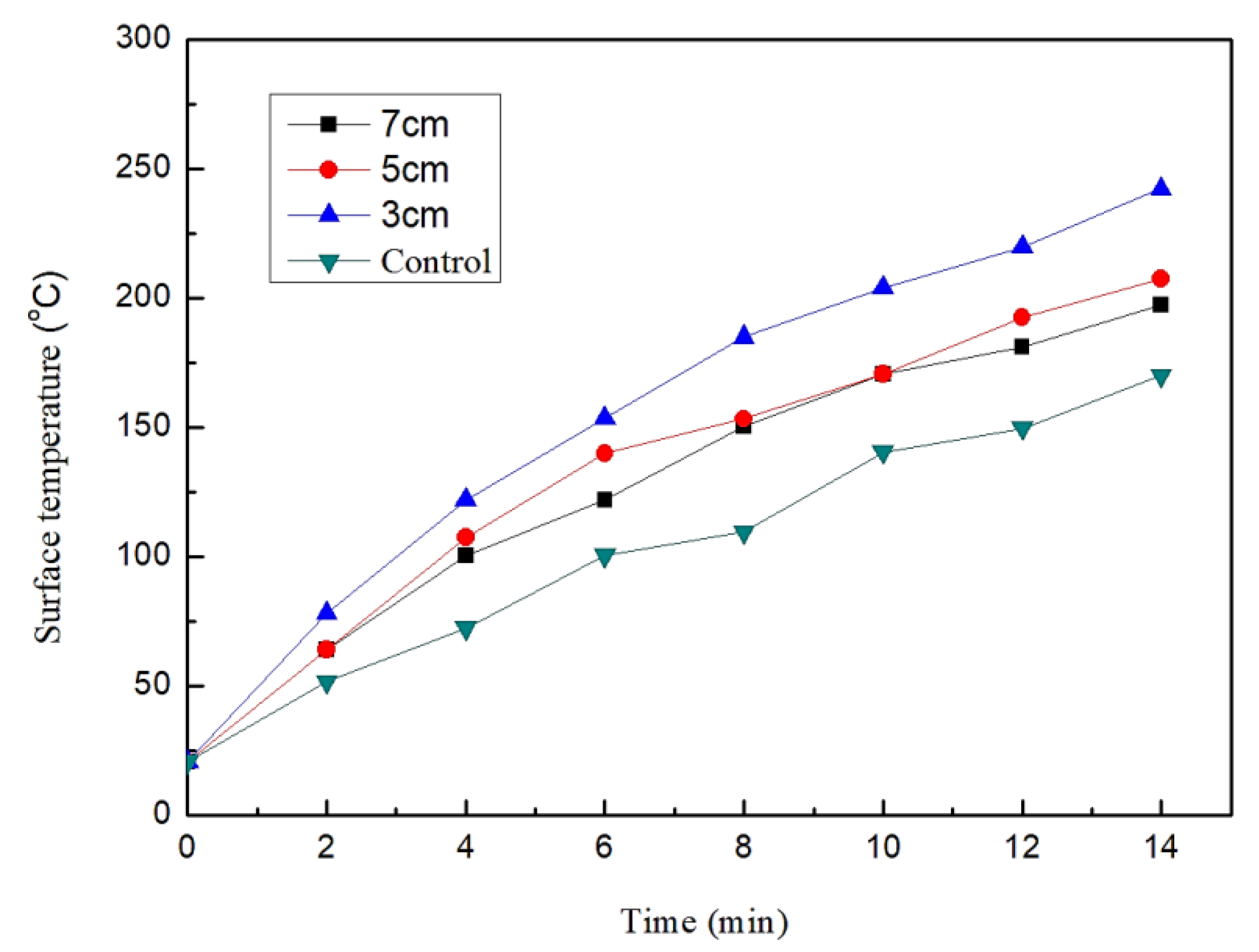
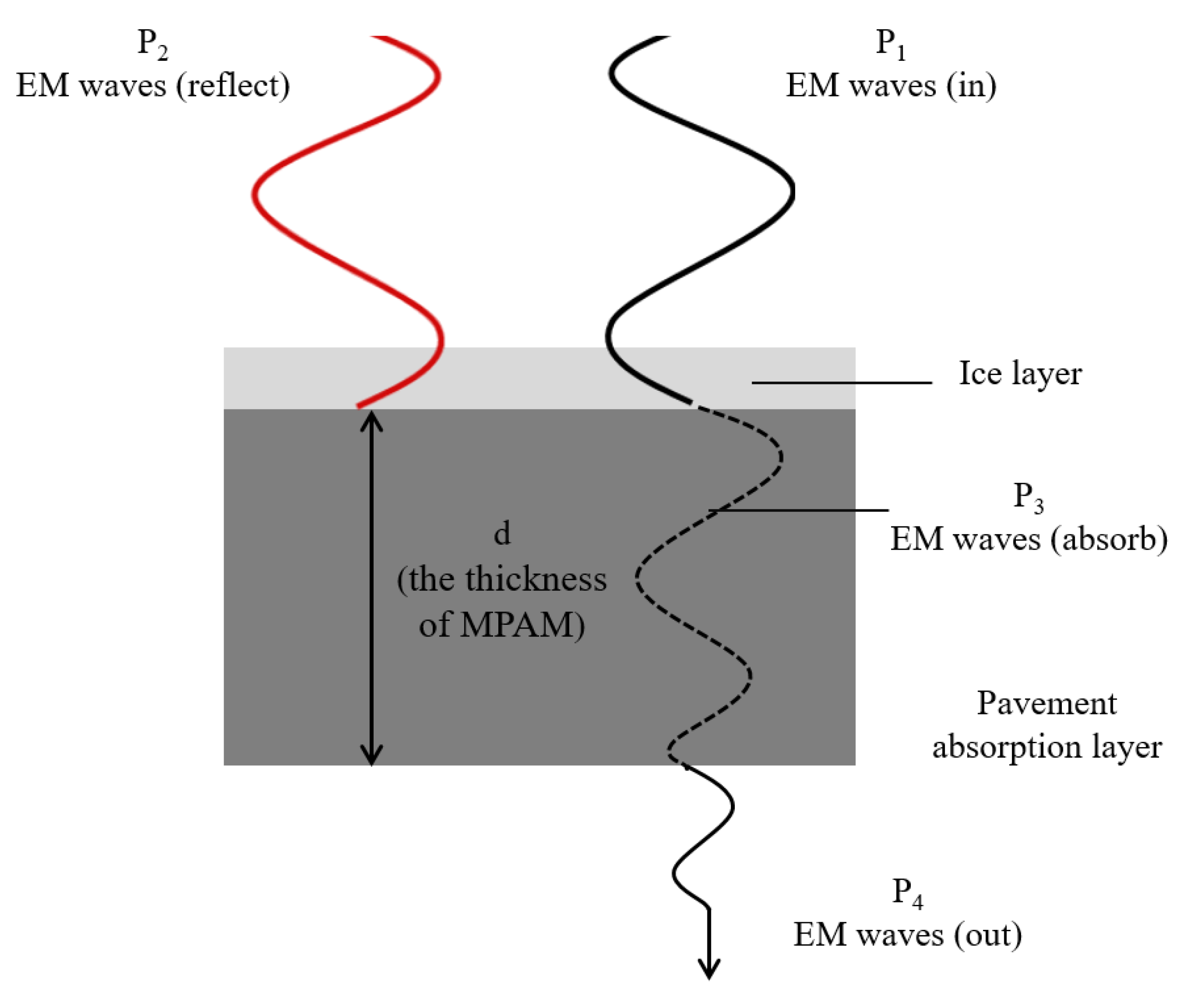
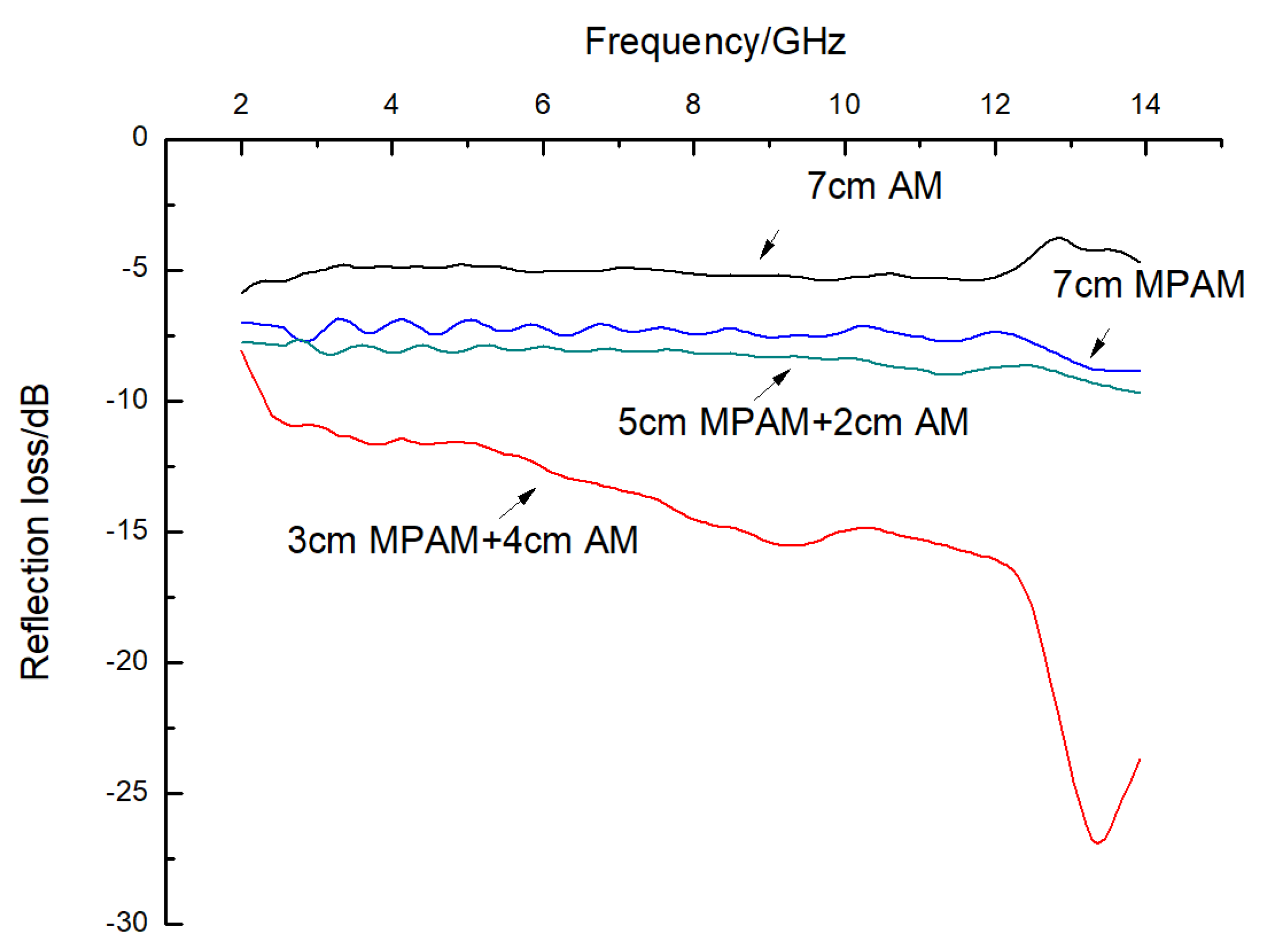
| Test Properties | Unit | Test Results | Test Basis |
|---|---|---|---|
| Needle penetration (25 °C) | 0.1 mm | 83.1 | ASTM D5-19 [20] |
| Soften point | °C | 47.4 | ASTM D36-14 [21] |
| Ductility (15 °C, 5 cm/min) | cm | >100 | ASTM D113-17 [22] |
| Wax content | % | 1.74 | ASTM D3344-90 [23] |
| Specific gravity | – | 1.030 | ASTM D70-18 [24] |
| Flash point | °C | 304 | ASTM D92-18 [25] |
| RTFOT (163 °C, 75 min) | |||
| Mass change | % | 0.05 | ASTM D2872-19 [26] |
| Penetration ratio (25 °C) | % | 82.7 | ASTM D5-19 |
| Ductility (10 °C) | cm | 29.3 | ASTM D113-17 |
| Crushing Value (%) | Los Angeles Wear value (%) | Density (g/cm3) | Water Absorption (%) |
|---|---|---|---|
| 18.4 | 20.7 | 2.639 | 0.70 |
| Filler | Density(g/cm3) | Water Content (%) | Hydrophilic Coefficient | 0.075 mm Percent Passing (%) |
|---|---|---|---|---|
| Magnetite powder | 4.6 | 1.1 | 1.43 | 75.7 |
| Limestone filler | 2.79 | 0.5 | 0.56 | 77.2 |
| Dosage of Magnetic Powder (%) | Regression Equation | K | R2 |
|---|---|---|---|
| 0 | T = 10.02t + 25 | 10.02 | 0.994 |
| 20 | T = 12.52t + 25 | 12.52 | 0.987 |
| 40 | T = 12.79t + 25 | 12.79 | 0.984 |
| 60 | T = 13.03t + 25 | 13.03 | 0.984 |
| 80 | T = 13.44t + 25 | 13.44 | 0.981 |
| 100 | T = 14.16t + 25 | 14.61 | 0.981 |
| Thickness (cm) | Regression Equation | K | R2 |
|---|---|---|---|
| 3 cm MPAM + 4 cm AM | T = 17.35t + 25 | 17.35 | 0.985 |
| 4 cm MPAM + 3 cm AM | T = 14.55t + 25 | 14.55 | 0.986 |
| 7 cm MPAM | T = 13.76t + 25 | 13.76 | 0.988 |
| 7 cm AM | T = 10.82t + 25 | 10.82 | 0.966 |
© 2019 by the authors. Licensee MDPI, Basel, Switzerland. This article is an open access article distributed under the terms and conditions of the Creative Commons Attribution (CC BY) license (http://creativecommons.org/licenses/by/4.0/).
Share and Cite
Guan, B.; Liu, J.; Zhao, H.; Wu, J.; Liu, J.; Yang, F. Investigation of the Microwave Absorption of Asphalt Mixtures Containing Magnetite Powder. Coatings 2019, 9, 813. https://doi.org/10.3390/coatings9120813
Guan B, Liu J, Zhao H, Wu J, Liu J, Yang F. Investigation of the Microwave Absorption of Asphalt Mixtures Containing Magnetite Powder. Coatings. 2019; 9(12):813. https://doi.org/10.3390/coatings9120813
Chicago/Turabian StyleGuan, Bowen, Jianan Liu, Hua Zhao, Jiayu Wu, Jingyi Liu, and Fa Yang. 2019. "Investigation of the Microwave Absorption of Asphalt Mixtures Containing Magnetite Powder" Coatings 9, no. 12: 813. https://doi.org/10.3390/coatings9120813
APA StyleGuan, B., Liu, J., Zhao, H., Wu, J., Liu, J., & Yang, F. (2019). Investigation of the Microwave Absorption of Asphalt Mixtures Containing Magnetite Powder. Coatings, 9(12), 813. https://doi.org/10.3390/coatings9120813






